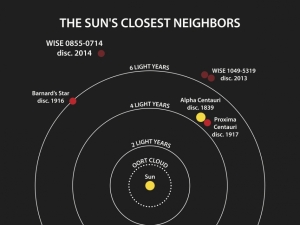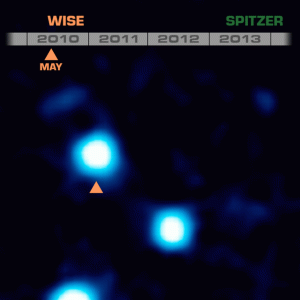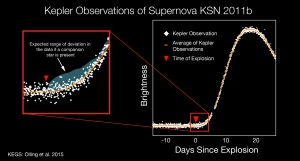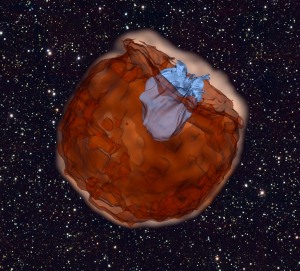
A frosty, chilly star about the same temperature as the North Pole, minus 54 and 9 degrees Fahrenheit (minus 48 to minus 13 degrees Celsius)
Space news (astrophysics: faint, cool stars; brown dwarfs) – the fourth closest detected star system to Earth, just 7.2 light-years toward the constellation Hydra –
A young, ambitious astronomer working at Pennsylvania State University’s Center for Exoplanets and Habitable Worlds discovered the dimmest, coolest brown dwarf detected during the human journey to the beginning of space and time. Kevin Lehman first noticed a fast moving object, quickly dubbed WISE J085510.83-071442.5, in March of 2013. Excited at a new discovery, he spent the next few days analyzing more images of the same part of the sky taken by NASA’s Spitzer Space Telescope and Gemini South Telescope on Cerro Pachon in Chile.

“It’s very exciting to discover a new neighbor of our solar system that is so close,” said Kevin Luhman, an astronomer at Pennsylvania State University’s Center for Exoplanets and Habitable Worlds, University Park. “And given its extreme temperature, it should tell us a lot about the atmospheres of planets, which often have similarly cold temperatures.”
Kevin Luhman originally spotted the fast motion of WISE J085510.83-071442.5 in infrared images taken by NASA’s Wide-field Infrared Survey Explorer (WISE). Later analysis of infrared images taken by NASA’s Spitzer Space Telescope were needed to determine its chilly temperature of between minus (54-9) Fahrenheit [minus (13 – 48) degrees Celsius]. Astronomers would use measurements taken by Spitzer and WISE at different positions around the sun to determine its distance of 7.2 light-years from Earth using the parallax effect. To scientists, it added up to a brown dwarf or maybe a large Jupiter-size planet lost in space.
“This object appeared to move really fast in the WISE data,” said Luhman. “That told us it was something special.”

Additional calculations estimated the mass of WISE J085510.83-071442.5 at between 3 and 10 times the mass of Jupiter. It could be a gas giant like Jupiter that was flung out of its host star system by gravitational interactions with more massive bodies. Astronomers determined it was more likely a very cool brown dwarf than a large gas giant planet since they have been detected more often. If this is the case, it’s the coldest brown dwarf star discovered during the human journey to the beginning of space and time. A nice shiny feather in the hat of a young, aspiring astronomer on the rise.
“It is remarkable that even after many decades of studying the sky, we still do not have a complete inventory of the sun’s nearest neighbors,” said Michael Werner, the project scientist for Spitzer at NASA’s Jet Propulsion Laboratory in Pasadena, Calif. JPL manages and operates Spitzer. “This exciting new result demonstrates the power of exploring the universe using new tools, such as the infrared eyes of WISE and Spitzer.”
Work’s never done
Never one to rest on his laurels, in March of 2013, Kevin Luhman discovered a pair of warmer brown dwarf stars just 6.5 light-years from Earth during his analysis of WISE images. Since this time, his search for rapidly moving bodies close to Earth has also shown that the outer solar system probably doesn’t contain a large, undiscovered planet X or Nemesis, as people often refer to it. I did mention he was ambitious.
Learn more about WISE J085510.83-071442.5.
You can learn more about Kevin Luhman here.
Take the space journey of NASA.
Learn more about the Spitzer Space Telescope.
Tour NASA’s Jet Propulsion Laboratory here.
Learn more about the Wide-field Infrared Survey Explorer.
Discover the work being done by Pennsylvania State University’s Center for Exoplanets and Habitable Worlds.
Discover the Gemini South Telescope on Cerro Pachon in Chile.
Read about a recent observation by the Kepler Space Telescope of a supernova shock wave in visible light.
Learn more about the incredible polynesian navigators and how they populated the islands of the Pacific Ocean.
Read about a supermassive black hole astronomers recently found residing in a galactic backwater.






